-
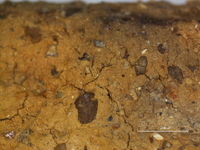 AF TBO 202 OM acquisition
AF TBO 202 OM acquisition Optical microscopy on surface and reflected light microscopy on pottery shard.
-
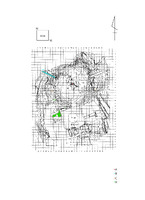 Batch C location
Batch C location All pottery shards found in Area C from Tatetsuki mound site.
-
 Batch B location
Batch B location All pottery shards found in Area B from Tatetsuki mound site.
-
 Batch A location
Batch A location All pottery shards found in Area A from Tatetsuki mound site.
-
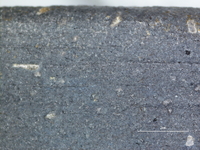 AF TBO STC 201 OM acquisition
AF TBO STC 201 OM acquisition Optical microscopy on surface and reflected light microscopy on pottery shard.
-
AF TBO 169 CT acquisition
X-rays Computed Tomography acquisition of metal shard.
-
AF TBO 167 CT acquisition
X-rays Computed Tomography acquisition of metal shard.
-
AF TBO 166 CT acquisition
X-rays Computed Tomography acquisition of metal shard.
-
AF TBO STC 161A CT acquisition
X-rays Computed Tomography acquisition of metal shard on non-polished and polished (by a soft brush) areas.
-
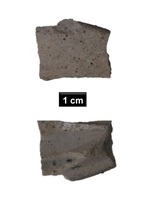 AF TBO 210
AF TBO 210 Debris on rim of lidded dish. (Sue ware). It is difficult to define as part of the body or lid. Found outside the stone chamber (6tr).
-
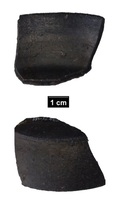 AF TBO STC 209
AF TBO STC 209 A fragment of the rim of the pedestal plate (Sue ware).
-
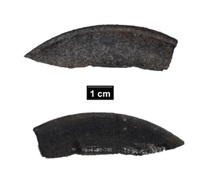 AF TBO STC 208
AF TBO STC 208 Bowl foot fragment (Sue ware).
-
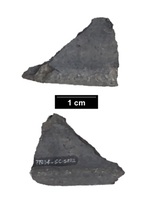 AF TBO STC 207
AF TBO STC 207 Pottery fragment (Sue ware).
-
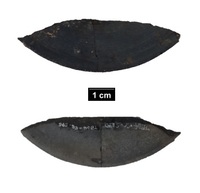 AF TBO STC 206
AF TBO STC 206 Fragment of a foot pedestal (Sue ware).
-
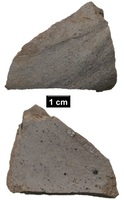 AF TBO 205
AF TBO 205 Dish fragment (Sue ware).
-
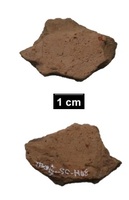 AF TBO STC 204
AF TBO STC 204 Haji ware of pedestal dish (low fired earthenware).
-
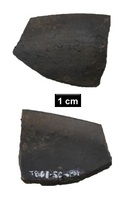 AF TBO STC 203
AF TBO STC 203 Fragment of a pottery lid (Sue ware).
-
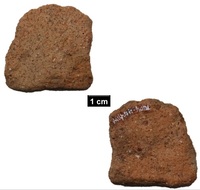 AF TBO 202
AF TBO 202 Haji ware. Pedestal plate (low fire earthenware).
-
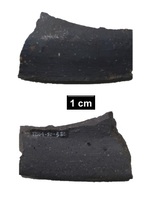 AF TBO STC 201
AF TBO STC 201 Fragment of a pottery lid (Sue ware).
-
 Tatetsuki and Shimane Pottery - XRPD data
Tatetsuki and Shimane Pottery - XRPD data XRPD data acquired in February 3rd 2021. Data were collected in the 3-80° 2-Theta range by using an automated Rigaku 'MiniFlex' diffractometer with Theta/2-Theta setup in Bragg-Brentano geometry.
Mineralogical analyses were obtained by processing experimentally collected data with the Diffrac Plus (2005) software (EVA 11,00,3).
-
 Guidelines for ceramic shard analysis in stereomicroscopy
Guidelines for ceramic shard analysis in stereomicroscopy Optical microscopy on surface and reflected light stereomicroscopy on pottery shard.
The microscopic observation of the fragment was carried out to make a general characterization of ceramic materials. The guidelines applied for the examination of each sample was evaluated:
• The technological class (ceramic)
• The shape and size of the sample (length, width, and thickness)
• The presence of decorations (incisions, impressions, and rims)
• The potential presence of pigment
• The type of paste and its colour
• The amount of inclusions present (low, medium or high)
• The shape (rounded, sub-rounded, sub-angular and angular) and dimensions (fine to coarse) of inclusions
• The presence of iron-oxides
• The potential presence of conservation interventions (glue, gypsum, label ink and label paper)
Instrument: Nikon SMZ745T.
Lens: SM-LW61Ji3 version 3
-
AF TBO STC 175A XRF processing and modeling
Qualitative analysis observing the spectra peaks of the measurements performed on the residual coating of the finding. Finer processing (as quantitative analysis) is prevented by the presence of alteration products and soil on the surface.
-
AF TBO 169 XRF processing and modeling
Qualitative analysis observing the spectra peaks of the measurements performed on the slightly polished area of the finding. Finer processing (as quantitative analysis) is prevented by the presence of alteration products and soil on the surface.
-
AF TTK 101 OM Data interpretation
Micromorphology of the surface of ceramic shard.
-
AF TBO STC 184 OM processing and modeling
Observation of metal shard by stereomicroscopy: exposed area of the shard, type of materials present and alteration products.
 AF TBO 202 OM acquisition Optical microscopy on surface and reflected light microscopy on pottery shard.
AF TBO 202 OM acquisition Optical microscopy on surface and reflected light microscopy on pottery shard. Batch C location All pottery shards found in Area C from Tatetsuki mound site.
Batch C location All pottery shards found in Area C from Tatetsuki mound site. Batch B location All pottery shards found in Area B from Tatetsuki mound site.
Batch B location All pottery shards found in Area B from Tatetsuki mound site. Batch A location All pottery shards found in Area A from Tatetsuki mound site.
Batch A location All pottery shards found in Area A from Tatetsuki mound site. AF TBO STC 201 OM acquisition Optical microscopy on surface and reflected light microscopy on pottery shard.
AF TBO STC 201 OM acquisition Optical microscopy on surface and reflected light microscopy on pottery shard. AF TBO 210 Debris on rim of lidded dish. (Sue ware). It is difficult to define as part of the body or lid. Found outside the stone chamber (6tr).
AF TBO 210 Debris on rim of lidded dish. (Sue ware). It is difficult to define as part of the body or lid. Found outside the stone chamber (6tr). AF TBO STC 209 A fragment of the rim of the pedestal plate (Sue ware).
AF TBO STC 209 A fragment of the rim of the pedestal plate (Sue ware). AF TBO STC 208 Bowl foot fragment (Sue ware).
AF TBO STC 208 Bowl foot fragment (Sue ware). AF TBO STC 207 Pottery fragment (Sue ware).
AF TBO STC 207 Pottery fragment (Sue ware). AF TBO STC 206 Fragment of a foot pedestal (Sue ware).
AF TBO STC 206 Fragment of a foot pedestal (Sue ware). AF TBO 205 Dish fragment (Sue ware).
AF TBO 205 Dish fragment (Sue ware). AF TBO STC 204 Haji ware of pedestal dish (low fired earthenware).
AF TBO STC 204 Haji ware of pedestal dish (low fired earthenware). AF TBO STC 203 Fragment of a pottery lid (Sue ware).
AF TBO STC 203 Fragment of a pottery lid (Sue ware). AF TBO 202 Haji ware. Pedestal plate (low fire earthenware).
AF TBO 202 Haji ware. Pedestal plate (low fire earthenware). AF TBO STC 201 Fragment of a pottery lid (Sue ware).
AF TBO STC 201 Fragment of a pottery lid (Sue ware). Tatetsuki and Shimane Pottery - XRPD data XRPD data acquired in February 3rd 2021. Data were collected in the 3-80° 2-Theta range by using an automated Rigaku 'MiniFlex' diffractometer with Theta/2-Theta setup in Bragg-Brentano geometry. Mineralogical analyses were obtained by processing experimentally collected data with the Diffrac Plus (2005) software (EVA 11,00,3).
Tatetsuki and Shimane Pottery - XRPD data XRPD data acquired in February 3rd 2021. Data were collected in the 3-80° 2-Theta range by using an automated Rigaku 'MiniFlex' diffractometer with Theta/2-Theta setup in Bragg-Brentano geometry. Mineralogical analyses were obtained by processing experimentally collected data with the Diffrac Plus (2005) software (EVA 11,00,3). Guidelines for ceramic shard analysis in stereomicroscopy Optical microscopy on surface and reflected light stereomicroscopy on pottery shard. The microscopic observation of the fragment was carried out to make a general characterization of ceramic materials. The guidelines applied for the examination of each sample was evaluated: • The technological class (ceramic) • The shape and size of the sample (length, width, and thickness) • The presence of decorations (incisions, impressions, and rims) • The potential presence of pigment • The type of paste and its colour • The amount of inclusions present (low, medium or high) • The shape (rounded, sub-rounded, sub-angular and angular) and dimensions (fine to coarse) of inclusions • The presence of iron-oxides • The potential presence of conservation interventions (glue, gypsum, label ink and label paper) Instrument: Nikon SMZ745T. Lens: SM-LW61Ji3 version 3
Guidelines for ceramic shard analysis in stereomicroscopy Optical microscopy on surface and reflected light stereomicroscopy on pottery shard. The microscopic observation of the fragment was carried out to make a general characterization of ceramic materials. The guidelines applied for the examination of each sample was evaluated: • The technological class (ceramic) • The shape and size of the sample (length, width, and thickness) • The presence of decorations (incisions, impressions, and rims) • The potential presence of pigment • The type of paste and its colour • The amount of inclusions present (low, medium or high) • The shape (rounded, sub-rounded, sub-angular and angular) and dimensions (fine to coarse) of inclusions • The presence of iron-oxides • The potential presence of conservation interventions (glue, gypsum, label ink and label paper) Instrument: Nikon SMZ745T. Lens: SM-LW61Ji3 version 3